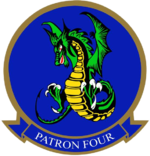VP-4
| Patrol Squadron 4 | |
|---|---|
 |
|
| Active | 1 July 1943 – Present |
| Country | United States of America |
| Branch | |
| Type | Squadron |
| Role | Anti-Submarine Patrol |
| Part of | Patrol and Reconnaissance Wing 2 |
| Garrison/HQ | Marine Corps Base Hawaii, Oahu, Hawaii |
| Nickname(s) | The Skinny Dragons |
| Engagements |
Cold War Vietnam War Operation Desert Shield Operation Desert Storm Operation Enduring Freedom Operation Iraqi Freedom |
| Aircraft flown | |
| Patrol |
PV-1 PV-2 P2V-1/2/5/5F/SP-2h P-3A/B/C |
Patrol Squadron Four (VP-4) is a U.S. Navy land-based patrol squadron based at the Marine Corps Base Hawaii, Oahu, Hawaii, which is tasked to undertake maritime patrol, anti-submarine warfare (ASW), and intelligence, surveillance and reconnaissance (ISR) missions flying the Lockheed P-3 Orion.
The squadron was originally established as Bombing Squadron 144 (VB-144) on 1 July 1943, redesignated Patrol Bombing Squadron 144 (VPB-144) on 1 October 1944, redesignated Patrol Squadron 144 (VP-144) on 15 May 1946, redesignated Medium Patrol Squadron (Landplane) 4 (VP-ML-4) on 15 November 1946 and redesignated Patrol Squadron FOUR (VP-4) on 1 September 1948. It is the second squadron to be designated VP-4, the first VP-4 was redesignated VP-22 on 1 July 1939.
VB-144 was established at NAS Alameda, California on 1 July 1943, as a squadron flying the PV-1 Ventura, by 14 August The squadron completed training and boarded USS Copahee for transport to NAS Kaneohe Bay, Hawaii. Upon arrival the squadron began an intensive period of combat training and operational patrols over the ocean near the Hawaiian Islands. On 9 January 1944 VB-144 was transferred to Hawkins Field, Tarawa, where combat patrols commenced as soon as the squadron was checked in and assigned space for the crews and aircraft. On 1 February 1944, the squadron was relocated to Dyess Field, Roi Island, from which bombing missions were carried out against Japanese installations in the Gilbert, Marshall and Eastern Caroline island chains. On 30 March 1944 VB-144 was transferred back to Tarawa, leaving a three-aircraft detachment at Dyess Field, which was engaged in strikes on 1 April 1944 against enemy positions at Wotje Atoll and Jaluit Atoll that continued through June. On 4 April 1944 the increasing tempo of operations at Dyess Field resulted in the deployment of a second detachment of VB-144 aircraft to Roi Island and by 1 September the remainder of the squadron was transferred to Dyess. On 30 September 1944 VB-144 was transferred to NAS Kaneohe Bay and was redesignated VPB-144 while preparing for return to the continental United States. On 1 November 1944 VPB-144 was reformed for training at NAS Whidbey Island, Washington. The squadron was reequipped with the newer PV-2 Harpoon. On 3 March 1945 the squadron commenced training in air-to-ground attack continued at NAS Moffett Field, California. From 8–15 April 1945 VPB-144 squadron personnel and equipment were loaded aboard USS Kadashan Bay for transport to Naval Base Pearl Harbor, Hawaii, arriving on 15 April. Upon arrival, the squadron was based at NAS Kaneohe Bay, where a combat training syllabus of several weeks was undertaken. From 11–23 May 1945 a detachment of squadron aircraft and crews was flown to Midway Island to provide combat air patrol coverage. On 23 May 1944, the detachment was increased to nine aircraft. On 24 May 1945 two of the crews sent to Midway earlier returned to NAS Kaneohe Bay. The remainder of the detachment followed, rejoining the rest of the squadron on 12 June 1944. On 27 June 1945 VPB-144 was transferred to Eniwetok, via Johnston Atoll and Majuro. The squadron was placed under the operational control of TF 96.1. Sector and photographic reconnaissance patrols were conducted over Wake and Ponape islands. By 12 September 1945, problems with malaria on Wake Island became so severe that the aircraft of VPB-144 were fitted with sprayers to cover the island with DDT. On 15 September 1945 flights were conducted over Kusaie, Ponape and the Caroline Islands as a show of force to the remaining Japanese troops who had not yet surrendered. By 15 May 1946: Squadron assets remained at NAB Tinian but all personnel were rotated back to the U.S., leaving the squadron in a caretaker status. In September 1946 the squadron was retained on the Navy roster, but was placed in an inactive status at NAS North Island, California, under FAW-14. In Nov 1947 the squadron was reactivated as VP-ML-4 at NAS Miramar, California, with a complement of 14 officers and 59 enlisted men. An SNB-5 was utilized for flight training until the arrival of the squadron’s first operational aircraft, the P2V-1 Neptune, in mid-December 1947.
...
Wikipedia
